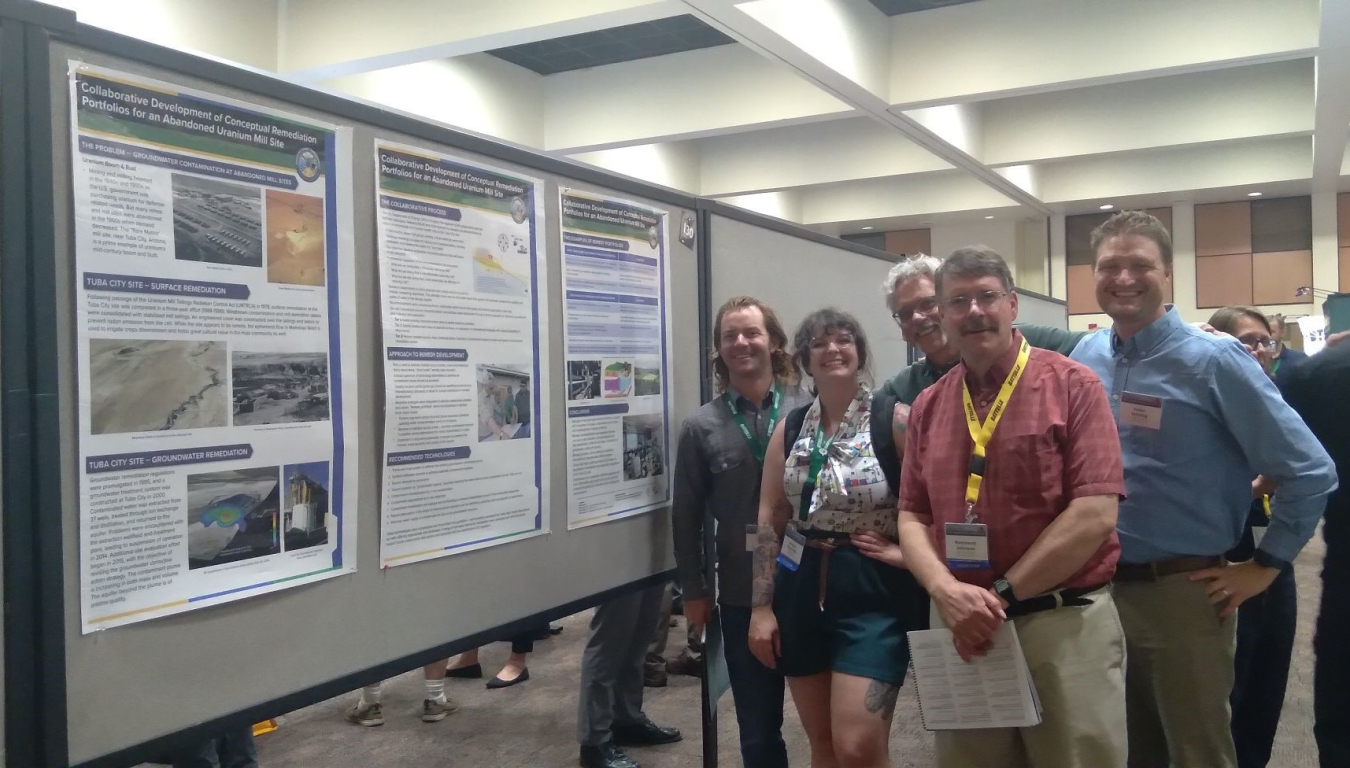Conference hosted by Battelle gives LM another tool to keep up with new and evolving remediation strategies.
July 6, 2022The U.S. Department of Energy Office of Legacy Management provides long-term stewardship at 101 former U.S. nuclear weapons complex sites across the nation. Many of these sites are contaminated to some extent with radioactive or hazardous materials, and LM’s mission is to ensure legacy contamination from those materials do not present exposure risks to people or the environment near these sites.
An important tool in managing the risks at LM sites is staying abreast of new and changing environmental remediation technologies. One way to do that is by participating in environmental conferences where government and private sector organizations present and collaborate on cutting edge technologies that are used to clean up contamination.

From left, Mike Morse (RSI-hydrogeologist), Allison Reynolds (RSI-geochemist), Pete Lemke (Geosyntec–chemical engineer), Ray Johnson (RSI-geochemist) and Pete Schillig (RSI-hydrogeologist) view one of the LM posters on display at the Twelfth International Conference on Remediation of Chlorinated and Recalcitrant Compounds, May 22-26, 2022, in Palm Springs, California.
A recent premier environmental conference was the Twelfth International Conference on Remediation of Chlorinated and Recalcitrant Compounds, held from May 22-26, 2022, in Palm Springs, California. Hosted by Battelle, more than 1,600 private and government sector scientists and engineers from around the world gathered to create a portrait of an ever-evolving environmental industry; identifying key current issues, determining how the issues are being understood and addressed, and finding solutions for those issues.
LM Site Manager Angelita Denny and a team of nine LM contractors and partners, including LM’s Groundwater and Geochemistry Group and the Applied Science and Technology group, gave six presentations, three poster sessions and chaired a topic session on various environmental topics that impact LM’s legacy stewardship mission.
The conference demonstrated that LM scientists and engineers are practicing their craft at a very high level and are utilizing appropriate technologies, and also offered insight into what can be done to solve LM’s environmental issues, Denny said.
“These environmental and technical conferences give our team an opportunity to share and gather information on new and evolving technologies that could potentially be used at our sites in the future,” she said.
The LM participants also shared what they are learning about topics that included the natural flushing efficiency at former uranium mill sites, engineered covers for uranium mill tailings that are managed to enhance evaporation, improving contaminant transport model calibration, and what geochemical data is necessary for a reactive transport model to simulate cleanup timeframes and achieve site closure. A consistent theme heard from conference attendees who viewed the LM presentations was they had no idea the LM program existed and were impressed by the technical skills and knowledge of the LM team.
Visualization was a focus of the conference, with multiple sessions spanning one and a half days. The number of sessions offered for technical topics is a function of the number of abstracts submitted and accepted which shows that visualization is a current industry interest.
Most of the presentations primarily used visualization to graphically convey concepts, but LM’s Three-Dimensional Visualization and Volumetric Analysis to Update the Conceptual Site Model for a Former Uranium Mill Site presentation was one of the two that used 3-D imagery to quantify plume behavior, an indication that LM is an industry leader in using visualization. Visualizations are an effective way to communicate information, particularly with animations.
LM also uses visualization to calculate bulk plume metrics (average concentration, mass, volume and center of mass) that quantify plume temporal dynamics (contraction, stable, expanding). Unique in the industry, LM uses bulk plume metrics to calibrate contaminant transport models.
Nuclear Magnetic Resonance (NMR), a geophysics technique that quantifies hydraulic conductivity and identifies mobile/immobile portions within aquifers, was also addressed in multiple sessions at the conference. Results were used to update conceptual site models, optimize remedial systems, and as input to groundwater flow and transport models. The wide use and acceptance of this technique validates LM’s plans to use it to characterize hydraulic conductivity distribution at former uranium mill sites in Tuba City, Arizona, and Shiprock, New Mexico.
Collecting and applying contaminant mass flux data attracted significant attention at the conference. Mass flux data is being used to update site models, design and optimize remedial systems and strategies, and as input to groundwater flow and transport models. Collecting mass flux information was a National Laboratory Network recommendation to LM and is planned for the Shiprock site.
LM poster sessions included Collaborative Development of Conceptual Remediation Portfolios for An Abandoned Uranium Mill Site, Using Stream Geochemistry to Determine Groundwater/Surface Water Interactions at a Former Uranium/Vanadium Mill Site, and Modeling Evaluation and Uncertainty Analysis of Remediation Timeframes at a Former Uranium Mill Site Using an Iterative Ensemble Smoother.
LM’s participation in the conferences like this, given the positive feedback and responses from many attendees, is evidence that LM is successfully acquiring new technologies and techniques to further improve their ability to protect the people and environment impacted by the nation’s nuclear legacies, Denny said.

